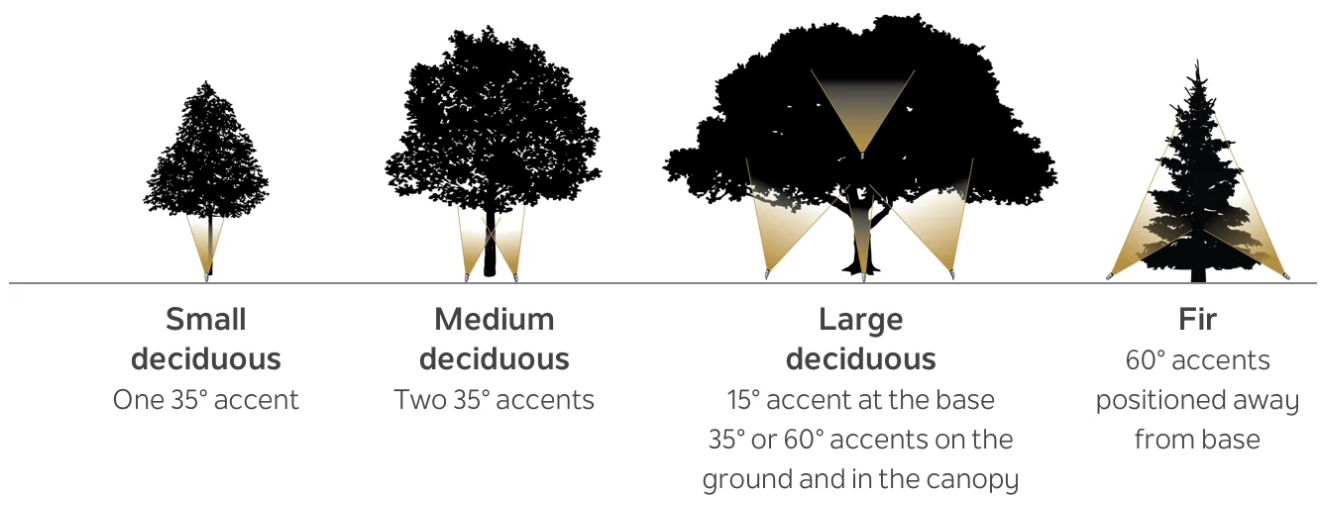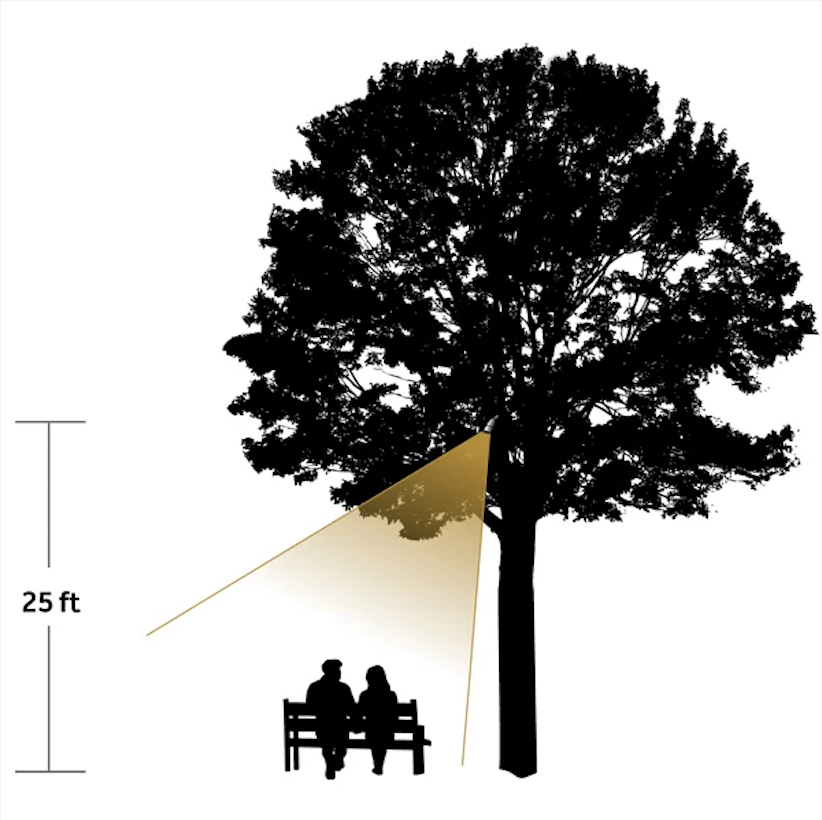Tree Lighting
Uplighting trees is dramatic and can create a focal point for the entire landscape lighting design. By comparison, downlighting is subtle and can create an inviting outdoor living space. Uplighting and downlighting can be used together on the same tree for maximum effect, or they can be used separately on different trees.
Uplighting
Uplighting trees is an art form that the landscape lighting contractor learns with time. Further, no two trees are the same, and how the tree is situated within the landscape design will affect how you illuminate it. Still, there are some basic rules that are helpful to refer to when you are lighting any tree in a landscape.
How to Create Uplighting
Small Deciduous
- Single accent 35°: Most small, deciduous trees only need one accent light, but it’s important to take viewing angle into account. If viewed from two angles, the tree may benefit from two accent lights.
- Canopy-aimed: The fixture should graze the trunk and point up into the canopy for maximum effect.
- Recommended fixture: Small VLO accent 35°
Medium Deciduous
- Cross-lighting: While it is possible to use one 60° accent, it is better in most cases to use two 35° lights because they will direct more concentrated light into the canopy.
- Position the accent lights so they graze the trunk but are focused on the canopy.
- Recommended fixtures: One small VLO 60° or two small VLO 35°
Large Deciduous
- Different angles: A large tree (60-100 feet) will require a combination of accent lights with different angles.
- Place one 15° accent light at the base of the tree, highlighting the trunk up to the point where the branches begin.
- Place 2-3 accent lights (35° or 60°) away from the trunk pointing into the canopy.
- Place 1-2 accent lights in the canopy, pointing up.
- Tree-mount junction box required: For each light in the canopy, use a tree-mount junction box (15609AZT) with stand-off screws so the tree has room to grow. Each junction box will provide a mounting location for one accent light. Connections and wire nuts go inside the box. Run wire up the non-visible or least-visible side of the trunk and fasten it to the trunk with cable clamps, making sure that the wire can still move with the tree. Leave some extra wire at the base of the tree to allow for tree growth.
- Recommended fixtures: Large VLO 15° for the trunk, large VLO 35° or 60° for the canopy
Larger Fir
- Total capture: Two accent lights with 60° beam spread light up the tree on two sides, creating 360° of visual interest.
- Greater distance: With firs, the fixtures should be placed farther away from the base and should shine directly onto the tree (rather than aiming up into the canopy).
- Recommended fixtures: Small or large VLO accent 35° or 60°
Downlighting
Downlighting makes a space inviting and delightful for social gatherings. It creates a special experience without the lighting itself being obvious. Downlighting can be installed on structures, such as pergolas or gazebos.
With a tall tree, downlighting can simulate the impression of moonlight and, with a gentle breeze, you will be able to see the shadows of branches and leaves at play on the ground. If you want to wow your customers, try enhancing one of their outdoor living spaces with downlighting.
How to Create Downlighting
Identify a large deciduous tree on the property that is a focal point of the landscape or near an outdoor living space. A large, tall tree is best, with branches that start high up, although you can use a smaller tree too.
Place one Small VLO 60° accent light at least four feet above the lowest tier of branches. About 20-25 feet from the ground is ideal. Point the accent light downward, experimenting with the right direction for creating shadows with the branches below.
You can place the light lower or higher, but you want to avoid situations where the light is buried behind too many branches or where the light is visible or blinding from below. Kichler Lighting sells a large variety of cowls that reduce the visibility of the light source





